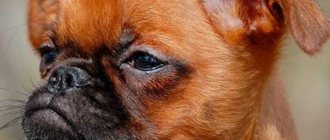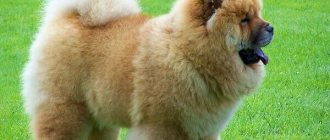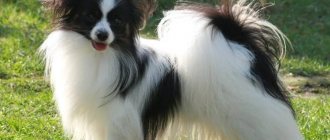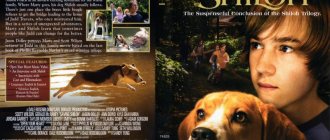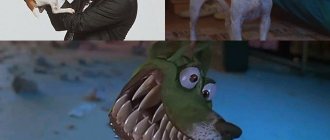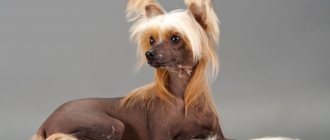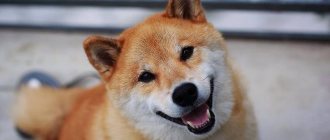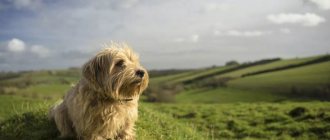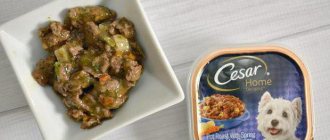The Finnish Lapphund or Finnish Lapphund (English: Finnish Lapphund, Finnish: suomenlapinkoira) is a hardy, calm, medium-sized dog breed native to the northern regions of Finland. The Finnish Lapphund was traditionally kept by the Sami, who have bred these dogs since time immemorial. The semi-nomadic Sami used it as a hunting dog, herding dog and livestock guardian, although in recent centuries the breed has been used mainly for herding reindeer. The breed is very popular as a companion dog in Finland, where it is regularly ranked among the top ten most popular dog breeds, but is very rare outside of Scandinavia.
Story
One of the most ancient species of four-legged friends of man belongs to the northern breeds. The Lapphunds are associated with the now extinct Sami people, who in ancient times inhabited Karelia and Ladoga.
Apparently, these charming creatures in the old days not only kept people company, but also occupied honorable positions in society. Their images can be found on various objects belonging to the shaman, for example, a tambourine. All this indicates an exceptional attitude towards furry creatures in ancient tribes.
It is noteworthy that they sometimes participated in hunting, but at the same time they are not at all aggressive creatures. The northern peoples, unlike European countries, did not engage in hunting animals and did not need fighting dogs either. They were busy with the process of survival and finding a way to make their life easier. At some point they managed to domesticate deer.
This gave many opportunities to people both in terms of speed of movement and quality of food. It was our heroes who occupied the positions of shepherds. They drove the herd into the pens allocated for them, guarded it, and at the same time the rest of the owner’s property.
Breeding the breed in factory conditions began only at the beginning of the twentieth century. The first standards were established in 1945, but at that time the name was different - Lapland Sheepdog . In 1955, the Fédération Cynologique Internationale recognized and registered the breed. Finnish Shepherds can also be called Lapp Laika. Each name is valid and used not only in Finland, but throughout the world. The dogs began to be called by their modern name only in 1993.
Today, Lapphund breeders have not achieved widespread popularity, but their charges are widely known and loved in Norway, Sweden and Karelia.
Full list
Below is a general list of the most popular breeds that have the universal features of a Spitz:
- Akita Inu;
- Alaskan Klee Kai;
- Alaskan Malamute;
- American Akita;
- American Indian dog;
- American Eskimo dog;
- volpino-italiano;
- East Siberian Laika;
- Greenland dog;
- Eurasier;
- West Siberian Laika;
- Icelandic Sheepdog;
- kai ken;
- Canadian Eskimo dog;
- Karelian bear dog;
- Keeshond;
- kintamani;
- kisyu;
- Korean Jindo (Jindo);
- Labrador Husky;
- Lapp reindeer dog;
- Mackenzie River Huskies;
- German Spitz;
- Norwegian Buhund;
- Norwegian Lundehund;
- Norwegian Elkhound;
- Nureongs;
- Pomeranian Spitz;
- Pungsan;
- Russian-European Laika;
- Samoyed husky;
- Northern Inuit dog;
- Seppala sled dog;
- Thai Bangkai Dog;
- Tamaskan dog;
- Shetland Sheepdog (Sheltie);
- Shiba Inu;
- Shikoku;
- Finnish Lapphund;
- Finnish Spitz;
- Canaan dog;
- Alaskan husky;
- Sakhalin husky;
- Siberian husky;
- Hokkaido;
- chow-chow;
- Swedish Lapphund;
- Swedish Vallhund;
- Schipperke;
- Yamthund;
- Japanese Spitz.
The variety of breeds in this group is impressive. Since ancient times, they have been faithful companions and helpers of man. And in our time, varieties of sharp-faced dogs are in demand and very popular.
Additionally, check out the video about Spitz breeds:
Standards
The established standards give us the following description of the breed:
- The average height at the withers is about forty-seven centimeters.
- Permissible weight is about twenty kilograms.
- The body shape is square.
- The head is quite large, especially in relation to the body. The forehead is convex. There is a narrowing towards the nose.
- The ears are set wide apart, in the form of small triangles.
- The eyes are slightly elongated. The iris is always dark in color. Brown and black colors are allowed.
- The teeth are straight, white and have a scissor bite.
- The chest is wide.
- The stomach is taut.
- The back is strong and level.
- The limbs are long, straight and parallel to each other.
- The tail is set quite high, of medium length, and abundantly covered with hair.
To read: Dog cocker poodle cockapoo: the character of a miniature pet with curly hair
Our beauties have long and thick fur. Falls in straight strands. The hair on the nose and limbs is much shorter. The undercoat is dense, thick and warm. Only dark colors are allowed as a color. White color is always in the minority. It is usually located on the chest, head, neck, muzzle, paws and tail.
Appearance
Let us immediately note that there are two breeds of Finnish Lapphund dogs; they have the same history, but different standards. The second variety is recognized as a separate breed in Switzerland and is called the Swedish Lapphund. Finnish representatives of the line are dogs of compact size, strong build, hardy and strong.
Against the backdrop of seasoned working qualities, representatives of the breed are charming in appearance and very graceful. In appearance, there is a close relationship with the Spitz; they have high legs and are richly dressed in upright wool. The tapering, moderately pointed muzzle and small pointed ears are both a breed characteristic and an ornament.
Among the standards of related breeds, the Finnish Lapphund occupies a special place. There are three related breeds in total: the Lapland Vallhund, the Finnish and the Swedish Lapphund. Representatives of the breed are clearly distinguishable by gender . Bitches are distinguished by their shortness, softer look, refined physique and gentle disposition. The weight of an adult dog ranges from 25–30 kg, height depends on gender:
- Male: 46–52 cm.
- Female: 40–46 cm.
The characteristics of the breed are very eloquent. The Finnish Lapphund is an active, alert, observant, curious dog, characterized by restraint and good obedience. Representatives of the breed lend themselves well to diversified training and are distinguished by their intuitiveness and ability to make decisions. When evaluating at the review, the complex impression is taken into account. Since the dog is in an unfamiliar environment, it must be alert, agile and under the control of the owner (handler).
Breed standard
- The head is wedge-shaped, proportional, not heavy. The forehead is wide, slightly convex. From the forehead to the muzzle there is a shallow dividing furrow; when palpated, the furrow is well defined, the transition to the muzzle is clear and harmonious. The brow and zygomatic arches are not heavy, but pronounced. The bridge of the nose is smooth, tapering evenly towards the nose. The cheekbones and chewing muscles are well developed, but dry. The jaws are deep, almost equal in length. The lips are not thick, dry, tightly fitting to the teeth, and fully pigmented.
- The teeth are large, set on the same line, in full set and in the correct bite.
- The nose is small, mobile, with open nostrils. The pigmentation is preferably black, but if the dog has no other faults, a color in harmony with the main color is acceptable.
- The eyes are expressive with an oval cut. Eye pigmentation is not strictly regulated: a rich brown color is preferred, but lightened color is acceptable if the eyes are in harmony with the coat color. The look is calm or interested, friendly.
- The ears are medium, but against the backdrop of lush fur they look small. The shape is triangular, with sharp apexes. The stance is wide, vertical or with a break in the second third. A dog's ears are almost always in motion or pointed towards the source of sound.
- The body has an almost square format, although the visual perception is slightly distorted by fluffy fur. The neck is carried and set proudly, of medium length, oval, muscular. The withers are moderately pronounced, but wide. The back is not long, strong, level with a short and strong loin. The croup is short, sloping, and quite powerful. The chest is oval, slightly elongated, wide, deep to the elbows. The front of the chest protrudes slightly forward. The groin line is neat, moderately toned.
- The limbs are elongated, smooth, strong with dry but pronounced muscles. When viewed from the front, the front legs are straight and parallel. The shoulder blades are slightly inclined towards the body, the shoulders are strong. Elbows and lower sternum line at the same level. The elbows are directed strictly back, free to move, the paw in this dark area is curved, which gives a large amplitude of swing when running. Due to this structure, during grazing or hunting, the dog may fall slightly on its front paws. Pasterns and wrists are almost vertical, strong and flexible. The hind legs have pronounced bones and are stronger than the front legs. When viewed from behind, the limbs are parallel; when viewed from the side, the angles of the joints are correct. The thighs are not long, wide with pronounced, not too dry muscles. The knees are large, strong, set strictly parallel to the axis of the body. The shins are elongated, the metatarsals are vertical, the hocks are flexible and strong. The brushes are large, slightly elongated, oval, compressed into a ball. The pads are noticeably convex, durable, protected by thick, coarse hair. Dewclaws are not considered a defect, but their presence is undesirable.
- The tail is of medium length, with a slight bend towards the tip, covered with thick and very long hair. Standing a little higher than the spine. When at rest, the tail is carried freely; when working, it is raised above the back, but not thrown over it.
Description of the breed
This is a very friendly, cheerful, cheerful and active dog. You will never get aggressiveness from him; he would rather try to run away from you than rush in with his teeth bared.
Due to their trusting attitude towards all humanity, Finnish huskies are completely unsuitable for home guarding. It is clear that herding deer is a completely unclaimed activity today, especially in large cities. Therefore, our friends are used only as companions.
This dog is just a fire starter. He can become a cure for any melancholy, a best friend, a family pet, not just a nanny, but a whole team of animators for your child. She is also amazing in her intelligence. She is easy to train, quickly learns and remembers commands, and is capable of making independent decisions. The Shepherd is focused on life with a person, so it does not experience any sense of competition, giving the reins of power into the hands of its owner.
At its core, this is a working breed of dog. They were called upon to help tribes in the most difficult situations. Along with hunting and walking cattle, Lapphunds are also famous for their rescue operations.
Very often they are involved in all kinds of services related to saving lives or search operations. They have excellent data for athletes. For fun, you can practice different games with your pet, such as throwing a stick or playing with a ball. They will also enjoy taking part in dog running competitions.
As rescuers, Lapp Laikas are very functional , because there are no obstacles for them in the form of a snow storm or too low a temperature. They are also often used as companions for people with disabilities.
It's hard to imagine what this dog couldn't handle. If he is entrusted with the protection of the territory, then he will undoubtedly explore it and raise his voice when he discovers someone else, but he may not be able to stand up for himself and for the owner’s property. Although here too there were examples where, with the right approach to training, our comrades turned out to be excellent watchmen.
Nutrition
Particular attention should be paid to feeding the breed. In order for your dog to be hardy and able to withstand extreme temperatures, he will need all the vitamins and minerals the body needs. The Swedish Lapphund is very intelligent and easy to train.
After all, these dogs have a fairly high level of intelligence. However, these dogs are unlikely to completely obey their owner. It must be remembered that they have a very independent character. The Swedish Lapphund's trust and respect still need to be earned. It is recommended to be firm during training. But by no means cruelty
The Swedish Lapphund is very intelligent and easy to train. After all, these dogs have a fairly high level of intelligence. However, these dogs are unlikely to completely obey their owner. It must be remembered that they have a very independent character. The Swedish Lapphund's trust and respect still need to be earned. It is recommended to be firm during training. But by no means cruelty.
During the period of raising the Swedish Lapphund, you will need to be persistent. Due to the fact that these pets are characterized by patience and a sharp mind, they are easy to learn and easy to train. But, since dogs are characterized by a kind of independence, during training the owner is recommended to demonstrate his own leadership qualities as much as possible, as well as strength of character, while avoiding cruelty. This will allow your pet to complete the training process successfully.
If a dog is kept in areas where a cold climate prevails, then its diet should be especially enriched with substances that provide energy. For the pet’s endurance and health, it is recommended to enrich the dog’s body with microelements and vitamins.
Mental and physical activity is necessary for these dogs to keep them healthy and happy. Therefore, dogs usually have a positive attitude towards the opportunity to exercise on the site with their owner. However, there are a number of nuances that owners should be aware of.
For example, a Pomeranian will refuse to complete tasks if it feels that it is being forced. In this case, he can be stubborn and show with all his appearance that he is proud and independent. You should not delay raising and training a new pet, and it is advisable to start doing this from the first days of its appearance in the house
Moreover, in this matter it is important to be consistent and methodical.
In some situations, the owner will have to be cunning, otherwise the beloved pet will demonstrate this quality with amazing ease.
It is important that the dog thinks that he is following commands solely of his own free will.
It is recommended to organize classes in such a way that they are varied, interesting, always contain new elements and cannot quickly get boring for such an inquisitive and quickly learning dog.
Swedish Lapphunds make excellent athletes; they show high results in agility, freestyle and other sports disciplines.
Maintenance and care
You shouldn’t even think about having such a cute pet in your apartment. The point is not even in his size, but in the fact that he is not used to such benefits. Moreover, he doesn't need them. Nature has rewarded him with a warm fur coat, and it should be used for its intended purpose.
To read: A cheerful pet with a sad look: getting to know the basset hound
At home, shedding continues for too long a period of time, unusual for the breed. And hair loss can result in either severe dermatitis or baldness. So your four-legged friend can only live outside. At best, he will agree, and a cozy, but not insulated booth.
Movement is simply vital for them. Having plenty of space makes them feel better. In the area near your home, they will be able to walk around, explore the secret corners of your yard, and hunt for rodents or birds. They will like this kind of life. Living in a confined space will simply kill the animal.
If you don't have enough space to let your pet out and let him frolic on his own all day, then you will have to find time for independent walks. Try to do this away from the roadway and too crowded streets.
Otherwise, care is not too burdensome for the owner. Check the condition of your teeth, nose, ears and eyes several times a week. Remove dirt with a slightly damp cotton swab. The coat will have to be brushed a couple of times a week. That's all.
Nature has not deprived Lapphunds of health. They are very hardy , patient, resistant to low temperatures and have a good immune system from birth. But this does not mean at all that they do not need to be vaccinated and undergo preventive medical examinations. Make sure your diet is correct and the food is fresh. They require good nutrition to maintain energy and warmth in any weather. The best decision would be to discuss the daily menu with your veterinarian.
Health of the Finnish Lapphund
The Finnish Lapp Laika does not suffer from hereditary diseases and is characterized by good health. With proper care, she may not even catch a cold in her entire life. But it is necessary to monitor her health in order to prevent possible problems. Like any other dog, the Lapphund must be vaccinated. An experienced veterinarian will help you decide what to vaccinate your dog with. In addition, there are a number of possible health complications that it is useful for the owner of a Finnish Lapphund to be aware of:
- Urolithiasis disease. All representatives of the breed are prone to it. It is treated with medications and, in advanced cases, with surgery. To prevent the disease, you should not give your dog cheap dry food or salt its food. Your pet should always have a full water bowl: water flushes excess salts from the body.
- Obesity. If a husky does not move enough, then it begins to rapidly gain excess weight, and this already leads to problems with the heart, digestion and musculoskeletal system. Prevention - a balanced diet and an active lifestyle.
- Skin diseases. Various parasites, getting into the thick coat of the Lapp Spitz, cause itching, irritation and even baldness. Prevention is the use of anti-parasite remedies recommended by your veterinarian.
Price
The hardest part about purchasing the right Finnish Shepherd puppy for your home is finding a kennel. There are not so many of them on Russian territory. There is a high probability of meeting official breeders in northern Europe. So if you prefer to vacation in those regions, you can immediately give yourself an excellent gift that will stay with you for fourteen years. This is how long representatives of this species of huskies live on average. Depending on your preferences and the puppy's pedigree, it can cost six hundred or seven hundred euros .
Brief historical background on origin
The Finnish Spitz, at the suggestion of a French gentleman, was spotted in his homeland, where he was especially popular among hunters. It is impossible to say exactly how ancient it is. During the war, like many others, she could have disappeared completely. At the end of 1880, she received a new impetus for life from amateurs who managed to increase the number and continue breeding.
Laika - “Karelian” received another, official name “Finnish Spitz” and went to neighboring countries. In the Russian Federation, on the territory of Karelia and St. Petersburg, there also remain a significant number of dogs that were actively bred by their neighbors - the Finns.
By the end of the 20th century, the dog mainly spread to America and EU countries. And to this day, in their historical homeland, their number greatly predominates.
Owner reviews
Several reviews:
- “I wanted a Husky for a very long time, but friends suggested getting a Lapphund, and I decided to try it. This is an incredible dog. No matter what mood I’m in when I return from work, just by looking at him I start to smile. I can’t even imagine how it was possible to manage without him for so many years.”
- “The Finnish husky is very beautiful, but completely unsuitable for an apartment. This option of keeping a dog turns into torture for both the owners and him. We tried and returned the pet back to the breeders.”
To read: Getting to know the Balinese cat (Balinese, Balinese) with an aristocratic appearance
Key points in training
Training the Karelian-Finnish Laika is not easy, but it is vitally important. Dogs are quick-witted, smart and active - such advantages must be directed in the right direction.
Note! Such pets are not suitable for long sessions, maximum 25 minutes. Tired dogs stop obeying and begin to act out.
Completed commands must be rewarded with treats. Spitz are very smart; if the owner manages to involve the animal in an activity and interest it, the pet will perform most of the exercises the first time.
Training begins from childhood, turning ordinary training into a game.
Links[edit]
- Pang, J.-F.; Kluetsch, C.; Zou, X.-J.; Zhang, A.-b.; Luo, L.-Y.; Angleby, H.; Ardalan, A.; Ekstrom, C.; Scollermo, A.; Lundeberg, J.; Matsumura, S.; Leitner, T.; Zhang, Y.-P.; Savolainen, P. (2009). "MtDNA evidence points to a single origin of dogs south of the Yangtze River, less than 16,300 years ago, from numerous wolves". Molecular Biology and Evolution
.
26
(12): 2849–64. DOI: 10.1093/molbev/msp195. PMC 2775109. PMID 19723671. - Duleba, Anna; Skoneczna, Katarzyna; Bogdanowicz, Wieslaw; Malyarchuk, Boris; Grzybowski, Tomasz (2015). "A complete mitochondrial genome database and standardized classification system for Canis lupus familiaris." International Forensic Medicine: Genetics
.
19
: 123–129. DOI: 10.1016/j.fsigen.2015.06.014. PMID 26218982. - Klütsch, C.F.C.; Savolainen, Peter (2011). "Regional occurrence, high frequency but low diversity of mitochondrial DNA of haplogroup d1 suggests recent dog-wolf hybridization in Scandinavia." Journal of Veterinary Behavior: Clinical Applications and Research
.
6
: 85. DOI: 10.1016/j.jveb.2010.08.035. - Thalmann, O.; Shapiro, B.; Cui, P.; Schuenemann, V. J.; Sawyer, SK; Greenfield, D.L.; Germonpre, M. B.; Sablin M.V.; Lopez-Giraldez, F.; Domingo-Roura, X.; Napierala, H.; Uerpmann, H.-P.; Loponte, D.M.; Acosta, A.A.; Giemsch, L.; Schmitz, R. W.; Worthington, B.; Buikstra, J. E.; Druzhkova, A.; Grafodatsky A.S.; Ovodov N.D.; Wahlberg, N.; Freedman, A.H.; Schweitzer, R. M.; Koepfli, K.-P.; Leonard, J.A.; Meyer, M.; Krause, J.; Paabo, S.; and others. (2013). "Complete mitochondrial genomes of ancient dogs suggest a European origin for domestic dogs." The science
.
342
(6160):871–4. DOI: 10.1126/science.1243650. PMID 24233726. - ^ B s d e g h i Jackson, Toni (2003). Finnish Lapphund: A Rare Breed Special Edition
. USA: Kennel Club Books. ISBN 1-59378-374-4. - Hartnagle-Taylor, Jeanne Joy; Taylor, Ty (2010). Stockdog Savvy
. Alpine Publications. ISBN 978-1-57779-106-5. - "OptiGen - PRA - Finnish Lapphund". www.optigen.com
. - "Introduction to the Sami People". boreale.konto.itv.se
. Retrieved February 28, 2022. - “Constitution and By-Laws (in force 2008) | Finnish Lapphund Club of Canada". www.finnishlaphund.ca
. Retrieved February 28, 2022. - "Finnish Lapphund". www.purina.com.au
. Retrieved February 28, 2022. - "Swedish Lapphund, multiple champion and multiple winner, Crystallens Lihkku, home page in English (Swedish Lapphund Reindeer Dog) www.lapphund.nu". www.lapphund.se
. Retrieved February 28, 2022. - "The Labrador Retriever was the most popular dog breed in Finland last year". www.kennelliitto.fi
. Retrieved February 28, 2022. - "United Kennel Club: Finnish Lapphund". www.ukcdogs.com
. Archived from the original on 2016-08-26. Retrieved February 28, 2017. - American Kennel Club. "Finnish Lapphund Dog Breed - American Kennel Club".
- ^ ab "Finnish Lapphund Club of America | History of the FLCA". www.finnishlaphund.org
. Retrieved January 12, 2022. - "History of the FLCGB Breed". www.finnishlapphund-club.co.uk
. Retrieved January 12, 2022. - “History of the Finnish Lapphund breed | Finnish Lapphund Club of Canada". www.finnishlaphund.ca
. Retrieved January 12, 2022.
Books
- Jackson, Tony (2003). Finnish Lapphund: A Rare Breed Special Edition
. USA: Kennel Club Books. ISBN 1-59378-374-4. - Karppinen, S. Dogs of Lapland. 2013. ISBN 978-952-5969-24-5.
further reading
- Klütsch CFC, Seppälä EH, Lohi H, Fall T, Hedhammar Å, Uhlén M, Savolainen P (2010) Regional occurrence, high frequency but low diversity of mitochondrial DNA haplogroup d1 suggests recent dog-wolf hybridization in Scandinavia. Animal genetics, online early.
Features of purchasing a puppy in Russia
A Finnish Spitz puppy can also be purchased in Russia. If you plan to participate in exhibitions (competitions, championships) or commercial breeding, you should pay attention to the documents. Often breeders provide only a certificate of origin of the puppy. However, the “real” document is considered to be the metric issued by the Russian Canine Federation.
It is better to purchase puppies from trusted breeders, checking documents in a timely manner
The Finnish Spitz is an incredibly intelligent and loyal breed. It is highly trainable and has phenomenal endurance. The animal is not suitable as a “couch” pet, as it requires long walks and constant exercise. A Spitz will become a devoted friend to one owner for life.
Character
With proper upbringing, your Karelian will be able to understand you and your mood
Karelian-Finnish dogs have a wonderful character, the main features of which are:
- mobility, cheerfulness and performance;
- courage, but not reckless;
- moderate aggressiveness towards strangers;
- attachment to the owner and his family;
- the ability to sense the owner’s mood and behave correctly.
With proper training, these dogs get along well with other animals living in the house and are also friends with children. They are attentive and if they consider something dangerous, they will certainly let the owner know by barking. Karelian-Finnish dogs have strong nerves and a good memory. They are distinguished by their loyalty and friendliness, which is why in Europe and the USA they are considered one of the best companion dogs.
